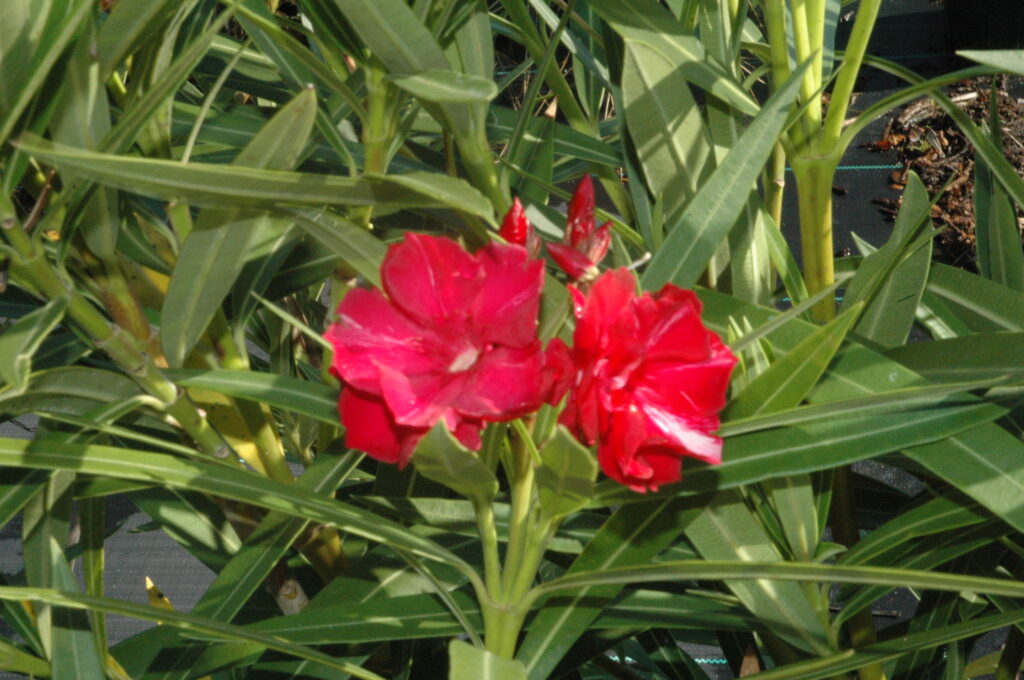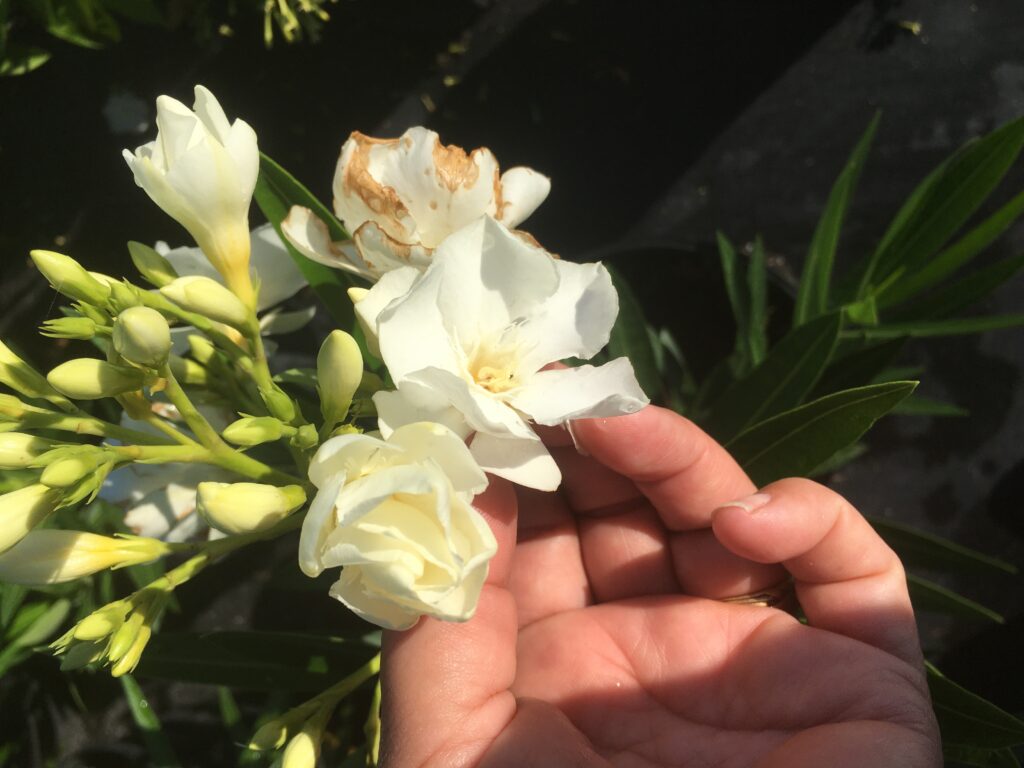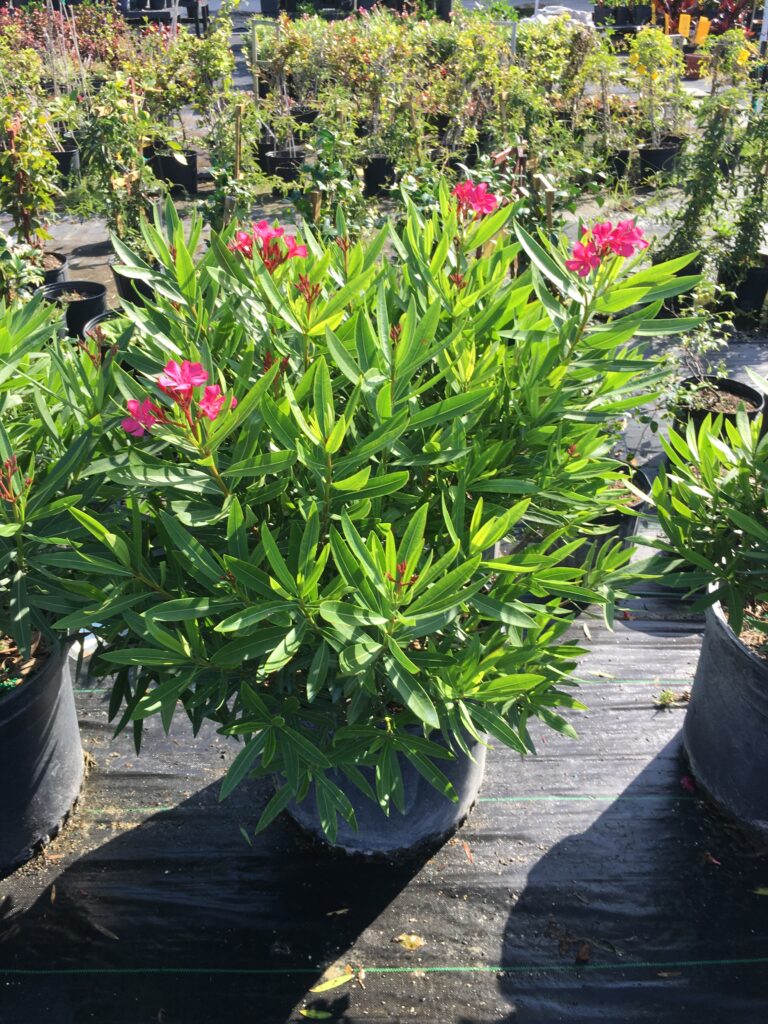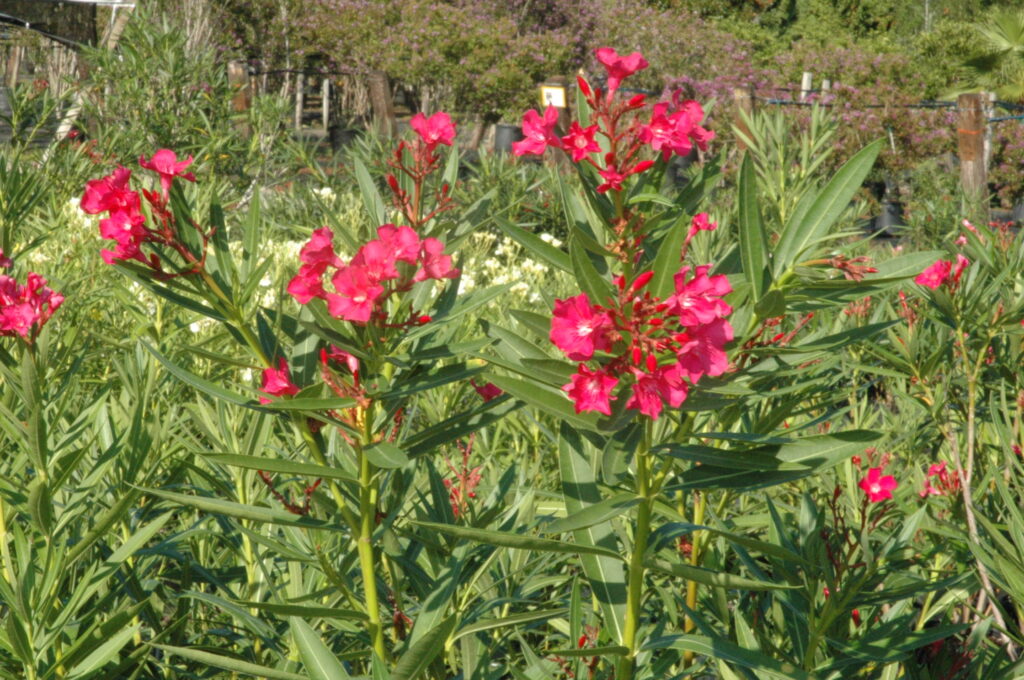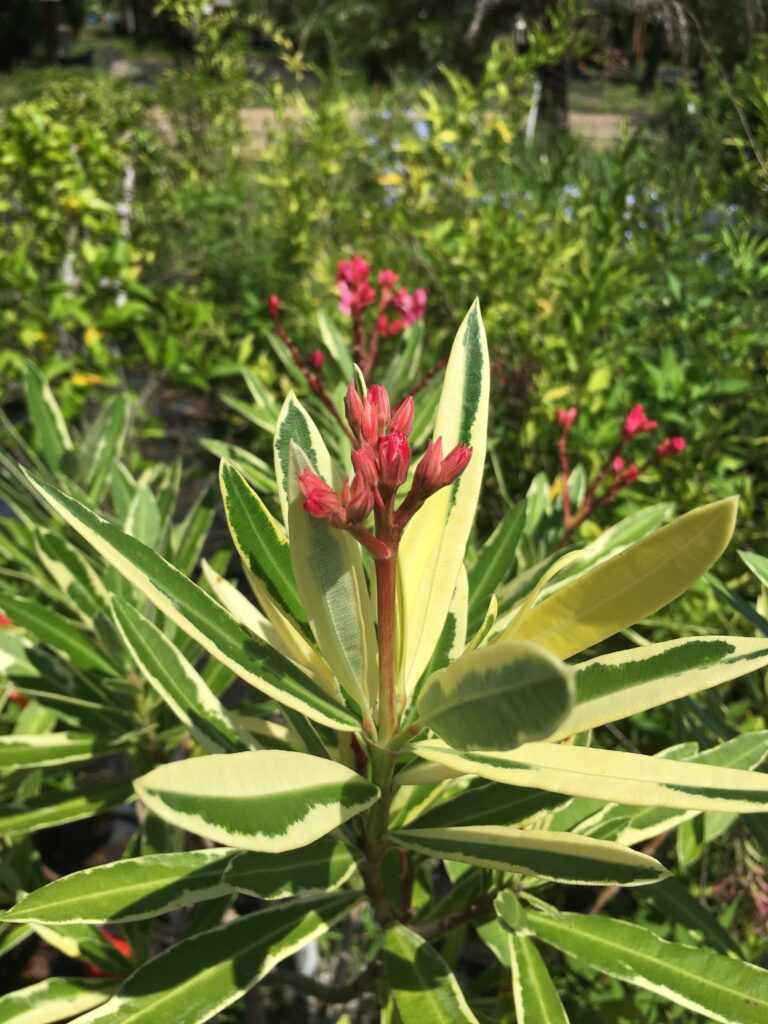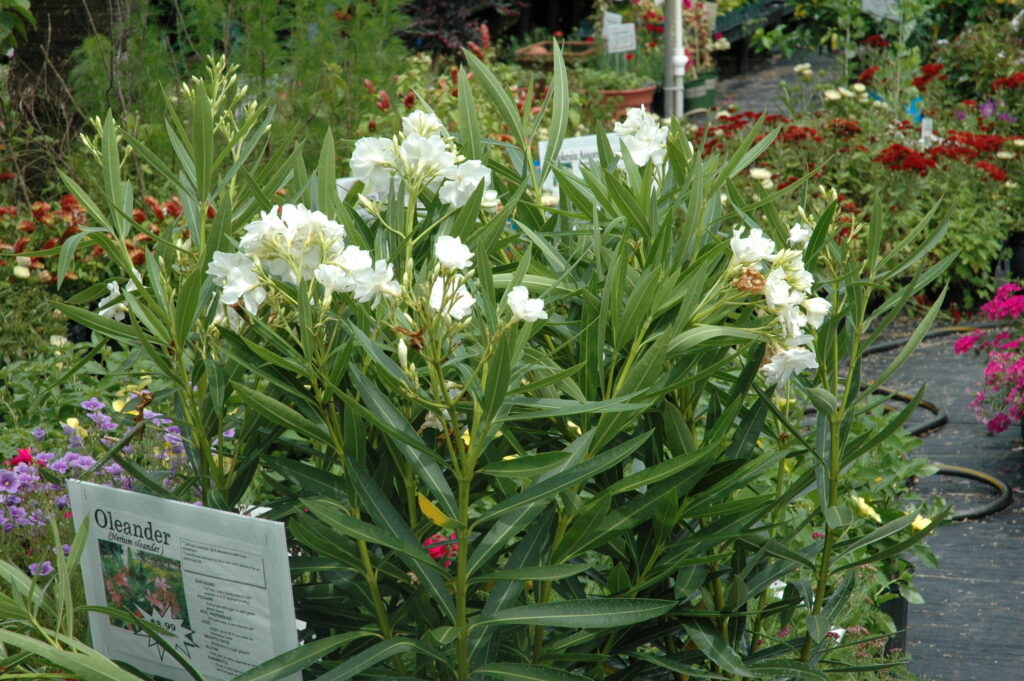S & J Nursery’s Guide to Growing
Oleander
for the Northeast Florida,
Jacksonville | St. Augustine area Landscapes
( Nerium oleander)
Origins of Nerium oleander plants:
– Native to southern Asia and the Mediterannean, Oleander is a wonderfully easy plant to take care of. Blooms come in an array of colors are born on the branch tips during spring summer and fall.
CAUTION: ALL PARTS OF OLEANDER ARE POISONOUS. Take care when planting in areas frequented by small children or pets that may decide to chew branches or leaves. Burning of the foliage will produce toxic fumes.
Preferred Exposure for Nerium Oleander:
– oleander should be planted into full sun location and will look its best in a when getting 6 or more hours of direct sunlight here in the Northeast Florida, Jacksonville | St. Augustine area landscape.
–Partial sun is also ok for oleander plants. Morning shade with afternoon sun is adequate but morning sun with afternoon shade may get you leggy plants with little blooms.
Foliage / of the Oleander Plant:
– Evergreen plant selection, oleander will retian its foliage during our winters unless damaged by a hard frost. Foliage should be protected from temperatures below 32 degrees. If winter damage occurs, wait until all danger of frost has passed for your area and remove any damaged leaves and stems. Plants should regrow quickly once the weather warms.
Soil Preference and Salt tolerance of the American Beauty Berry:
– Oleander will grow happily in dry sandy infertile soils and is widely tolerant of soil components including clay as long as they are planted into a well drained area. Oleander has a high drought tolerance and for that reason used to be frequently seen in Florida as roadside / median plantings where no additional irrigation is supplied.
– Nerium Oleander shrubs have a moderate salt tolerance and can be utilized for coastal plantings that are not receiving direct salt spray on a regular basis.
Size Variance of Oleander Plants :
– Can reach sizes of 8-15+ feet High | 6-10 feet Wide but respond well to pruning and can be maintained lower with annual pruning.
Space plants at a minimum of 5-8 ft from the center of one plant to the center of another for hedge screen or patio tree plantings.
Growth Habit of Oleander :
– Oleander has very upright stems that are quite vase shaped when young and eventually form a rounded hedge.
Growth Rate of the Oleander:
– Fast growing plants can easily add a foot or more to their height in ideal conditions in one growing season. If you are planning on maintaining these plants at a lower height, remember to trim 4-6 inches beneath where you would like to see the plants height and shape as they will re-flush new growth and blooms almost immediately after trimming. Expect to get 12″ or more of growth on established plants in a growing season until mature.
Blooms of the Oleander plant:
–Oleander blooms may be soft pink, red, hot pink, yellow and white may be in a single layer or a double layer depending on the selection you choose.
Plants flower in spring, summer and fall in zone 9a and year round in zones 9b-11.
Water Requirements of the Nerium oleander Plant :
– Oleander have fairly low water needs once they are established into the landscape and are considered drought tolerant.
Remember to check their water needs daily after planting to get them rooted and established into the landscape quickly.
– Watering your newly planted smaller shrubs and flowers
Butterfly or Bird Attracting:
- Due to their way of producing no nectar and using pollen aggregates for pollination they are not very attractive to pollinators and known as ‘unrewarding flowers’ although unlike all other parts of the plant their pollen is nontoxic to pollinators that do visit, so it does not harm them, the flowers just offer them no food source / nectar.
Best Uses For Nerium Oleander Plants in the Northeast Florida, Jacksonville | St. Augustine area Landscape :
– Oleander is a larger growing plant that is well suited to the back of the border planting in perennial or tropical garden settings. Or can be used as a small ornamental accent plant or patio tree if left untrimmed and allowed to grow to its maximum height or trimmed up as a standard single trunk specimen tree.
– Olenader are perfect for massed plantings for screening out unsightly views or in low water areas where other more sensitive plants may struggle to stay alive. Use caution to ensure you are planting your Olenader in areas not frequented by children or pets that may chew the foliage or be tempted to play with the flowers.
Care of S & J Nursery’s North Florida | Jacksonville | St. Augustine
Shrubs:
– Oleander can be pruned annually in the spring time to keep the plants full of foliage or remove any winter damage.
– Oleander shrubs can be planted in the North Florida | Jacksonville | St. Augustine area at any time during the year. In normal and well draining soils dig the hole as deep as the root ball and two to three times as wide. Plant the top of the root ball level or slightly higher than the surrounding soils. Avoid planting in poorly drained soils.
– Check the plants water needs every day during the establishment period. For most 3 gallon size shrubs in the North Florida landscape in average soil, that is neither heavy clay that holds water or really sandy that will take 2-3 weeks of daily watering to ensure that your newly planted shrub will begin to put out new roots and grow into its new home happily. After the first few weeks begin tapering back your watering to every other day then every third day and so on until your newly planted items are flourishing without your assistance.
– IMPORTANT: If planting shrubs in heavy clay soils that hold allot of water after a rain or irrigating, remember to check the soil for moisture by sticking your fingers into the soil near the root ball of the newly planted shrub down to 2-3 inches. If it remains wet from the previous watering wait for the top 2-3 inches to dry out before watering again.
IMPORTANT: When planting shrubs into poor sandy soils be sure to amend the planting hole by mixing compost or cow manure etc. with the native soil that will go back in the hole around the new plants root ball when installing your shrub material, this will not only give your new shrubs good soil to grow its new roots into but help it hold water. (Note: this is not necessary with oleander that will thrive in poor soils )
– When planting shrubs from containers be sure to loosen the roots as much as possible pulling loose roots away from the root ball before installing your new plants, if the roots are to tight to easily loosen with your hands use a knife to cut a few slits into the root ball being careful to go all
the way from the top to the bottom and making the cut at least an inch deep. This will ensure that your plant will immediately begin to form new roots into its new surrounding soil.
Planting your new smaller shrubs and flowering plants
– Mulch newly planted shrubs whenever possible. Shrubs will benefit from a 3-4 inch layer of arborists wood chips, Pine bark or Pine Straw.
– Trim back and winter damaged foliage or stems in spring once all danger of frost has passed. Fertilize each spring with a shovelful of good garden compost or a mixture of Milorganite and a good quality slow release poly coated plant food like Stay Green or Osmocote. Be sure when fertilizing to sprinkle the fertilizer around the mulch circle underneath the foliage of the shrubs.
https://www.south-florida-plant-guide.com/oleander.html
https://edis.ifas.ufl.edu/pdffiles/ST/ST41200.pdf
https://gardeningsolutions.ifas.ufl.edu/plants/trees-and-shrubs/shrubs/oleander.html



